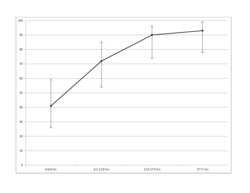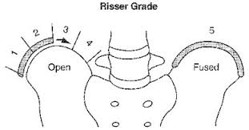What is BrAIST?
BrAIST stands for the Bracing in Adolescent Idiopathic Scoliosis Trial.
BrAIST was a research study at 25 hospitals in the US and Canada. The patients in the study all had adolescent idiopathic scoliosis. They were either braced or had no treatment for their scoliosis.
The study found that bracing worked - fewer patients ended up with large curves by the time they were done growing than those who didn’t have a brace.
BrAIST also found that the more hours a brace is worn, the lower the chance of the curve getting bigger. Click here to read more about the results of the trial in the New England Journal of Medicine.
What is BrAIST-Calc?
BrAIST - Calc estimates your risk of curve progression to >45 degrees while you’re still growing. Many doctors start talking about surgery at this point. Our predictions are not perfect, but they can help you and your doctor decide on the best course of treatment for you, based on your individual characteristics.
BrAIST - Calc uses a statistical model. A statistical model is a math equation. To create the equation we combined math with data from the BrAIST study. The model is a simplification of what happened to the patients in the study. We also tested the model on patients who were not in BrAIST to see how well it worked. The model is pretty accurate, and so we can feel comfortable using it to help predict what will happen to patients like you.
Using the statistical model, we can estimate the risk that a person’s curve will worsen to the point where the doctor might start thinking about surgery (>45° before skeletal maturity). BrAIST - Calc can estimate the risk for people who do not get treatment for scoliosis, and for those who are treated with a brace. Click here to read more about one of our models in the Journal of Spine Deformity.
What information is used in BrAIST-Calc?
BrAIST - Calc combines pieces of information about you to estimate your personal risk of curve progression.
Age
Scoliosis tends to increase during growth spurts. In the BrAIST-Calc model, 10 and 11 year-olds are at higher risk for curve progression and surgery than older patients.
BMI (Body Mass Index)
Your BMI is calculated from your height and weight. Patients with a low BMI have curves that are more likely to progress than those with a higher BMI. In BrAIST-Calc, patients with a BMI less than 20 are at higher risk for curve progression and surgery.
Maximum Cobb Angle
The Cobb angle measures how big your curve is in degrees. Many doctors recommend surgery if the Cobb angle is greater than 45-50 degrees (especially if you are still growing). In BrAIST-Calc, every degree greater than 27 increases the risk that the curve will progress to surgery.
Risser Grade
We look at your hip bones on an x-ray to determine what your Risser grade is. The Risser grade ranges from 0 (you have lots of growing to do) to 5 (you are almost done growing). Scoliosis tends to worsen while a patient is growing. In BrAIST-Calc, patients with a Risser grade of 0 have a much higher risk of curve progression and surgery than those with a Risser grade of 1 or more.
Braced Time
BrAIST and other research studies have shown that the more a brace is worn, the more effective it is. Some patients may need to wear their brace more than others for it to work.


